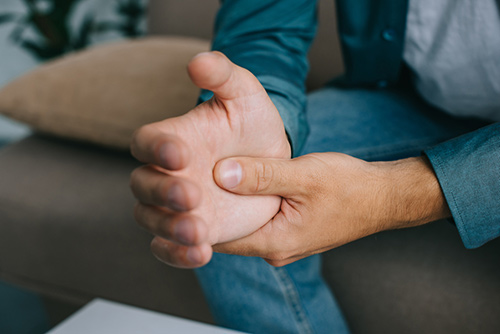
What causes carpal tunnel?
Since the bones, ligaments and connective tissue of the carpal tunnel are rigid, there is little room for expansion. Whether it’s the ligaments and bones creating the carpal tunnel or the ligaments and nerves running through it, carpal tunnel syndrome occurs when one for the parts involved becomes inflamed, narrowing the passageway and cause pain and discomfort in the area by placing pressure on the median nerve.
Symptoms include pain, numbness, weakness and tingling in the hand. These symptoms tend to begin gradually without a specific injury and can sometimes cause the same tingling sensations throughout the arm and up to the neck, where the median nerve attaches.
Heredity. Some people have smaller carpal tunnels than others due to heredity. These traits run in families and increase your likelihood of developing carpal tunnel syndrome.
Repetitive hand use. With use comes wear and tear. Occupations and activity with heightened hand use can leave people more susceptible to carpal tunnel syndrome.
Health Conditions. Rheumatoid arthritis, diabetes and problems with the thyroid gland can contribute to carpal tunnel syndrome.
How do you treat it?
Pain from carpal tunnel syndrome gradually worsens over time in most patients without any form of treatment. This is why it’s important to be evaluated by a doctor immediately to being treatments.
Nonsurgical treatments:
Bracing and immobilization. This is mostly done at night, but may be done during the day for more painful cases. This reduces movement and pressure on your wrist and gives the swelling time to subside.
Anti-inflammatory drugs. This includes ibuprofen, Aleve and other general anti-inflammatories. Over-the-counter anti-inflammatories may be recommended as well.
Activity Changes. Temporary, or sometimes permanent, changes of activity may be required to alleviate the pain and reduce the swelling. Whether this is temporary or permanent depends on the severity of the carpal tunnel.
Nerve Gliding exercises. These exercises are recommended by a doctor or physical therapist and help your median nerve move more freely throughout the tunnel.
Steroid Injections. Cortisone is one heck of a drug. Unfortunately, the relief is not permanent.
Surgical Treatment
Open Carpal Tunnel Release. This surgery essentially opens up the carpal tunnel to create more space for the nerves and ligaments which travel through it. The doctor makes a small incision in your palm and divides the carpal tunnel roof, increasing the size of the carpal tunnel. The ligament may gradually grow back after but there will still be more space and less pressure on the median nerve.
Endoscopic Carpal Tunnel Release. Similar to the open carpal tunnel release, except with a camera. The doctor makes one or two incisions in your pal and views the carpal tunnel with an endoscope, unlike open surgery that can be viewed with the naked eye. The doctor then uses the same method to divide the carpal tunnel to open in and release pressure on the median nerve.
Recovery
Strength is not expected to return for 2 to 3 months following surgery or even 6 to 12 months for more severe cases. Elevate your hand above your heart and wiggle your fingers to reduce the swelling, soreness and stiffness from the surgery. This soreness will likely last several weeks to several months.
Most surgeries turn into life-long success and improve the symptoms of carpal tunnel syndrome but the gradual recovery may take up to a year. If you’re suffering from carpal tunnel syndrome, or experiencing the symptoms, call our Board Certified Hand Surgeons Dr. Patrick Hurlbut and Dr. Gustavo Machado at Prairie Orthopaedic & Plastic Surgery today.

